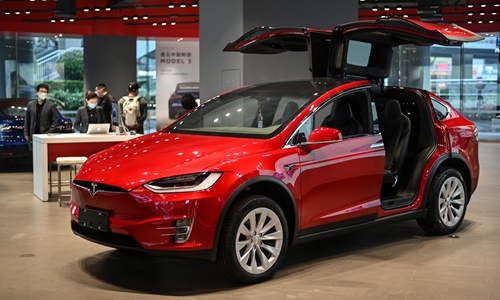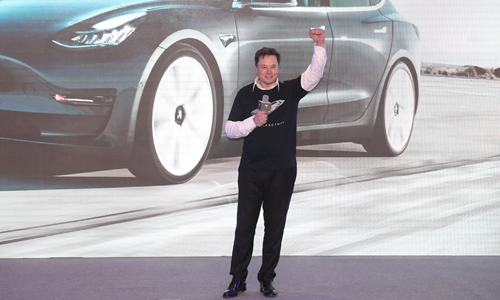How Elon Musk defines a new era for the global auto industry
Source: Reuters Published: 2020/7/23 18:58:40

A car in a Tesla showroom in Wuhan, Central China's Hubei Province on April 18. Photo: AFP
Tesla Inc's rapid rise to become the world's most valuable carmaker could mark the start of a new era for the global auto industry, defined by a Silicon Valley approach to software that is overtaking old-school manufacturing know-how.
Tesla's ascent took many investors by surprise. But executives at Daimler AG, the parent company of Mercedes-Benz, had a close-up view starting in 2009 of how Tesla and its chief executive Elon Musk were taking a new approach to building vehicles that challenged the established system.
Daimler, which bears the name of the man who invented the modern car 134 years ago, bought a nearly 10 percent Tesla stake in May 2009 in a deal which provided a $50 million lifeline for the struggling start-up.
That investment gave Mercedes engineers an inside view of how Musk was willing to launch technology that wasn't perfect, and then repeatedly upgrade it, using smartphone style over-the-air updates, paying little regard to early profitability.
Mercedes engineers helped Tesla develop its Model S luxury sedan in exchange for access to Tesla's partially hand-assembled battery packs, but in 2014 Daimler decided to sell its stake amid doubts Tesla's approach could be industrialized at scale.
Tesla would go on to pioneer new approaches in manufacturing, designs in software and electronic architecture which enable it to introduce innovations faster than rivals, leaving analysts to draw comparisons with Apple.
Three people directly involved with the Mercedes side of the collaboration said the brief partnership highlighted the collision of old and new engineering cultures: the German obsession with long-term safety and control, which rewarded evolution, and the Silicon Valley carmaker's experimental approach which embraced radical thinking and fast innovation.
"Elon Musk has been walking on the edge of a razorblade in terms of the aggression with which he pushes some technologies," said a former Mercedes engineer who worked on the partnership.
By contrast, Mercedes and other established automakers are still not comfortable about releasing a new technology, such as partially automated driving, without years of testing.
Tesla did not respond to requests for comment.
Investors favor the Tesla model, in an industry undergoing fundamental and dizzying change even though the US carmaker will face an onslaught of competing electric vehicles from established automakers during the next few years.
They are putting their money on Musk and his company, even though Mercedes-Benz alone sold 935,089 cars in the first half of 2020, dwarfing the 179,050 delivered by Tesla in the same period.
Today, Tesla is worth nearly $304.6 billion, more than six times Daimler's 41.5-billion-euro ($47.7 billion) market capitalization.

Tesla Inc CEO Elon Musk attends a delivery event for China-made Model 3 cars in Shanghai, China on January 7. Photo: cnsphoto
Two cultures collide
Daimler and Tesla began collaborating after Mercedes engineers, who were developing a second-generation electric Smart car, bought a Tesla Roadster. They were impressed by the way Tesla packaged batteries, so arranged a visit to Silicon Valley to meet Musk in January 2009 and ordered 1,000 battery packs.
The collaboration expanded. At a joint press conference in the Mercedes-Benz museum in Stuttgart in May 2009, Tesla said the partnership would "accelerate bringing our Tesla Model S to production and ensure that it is a superlative vehicle."
For its part, Mercedes wanted to use Tesla's batteries to power an electric version of its compact Mercedes-Benz B-Class. The Tesla Model S would hit the road in 2012. An electric B-Class arrived in showrooms two years later.
Despite having batteries supplied by Tesla, the Mercedes had a shorter operating range after Daimler engineers configured the B-class more conservatively to address their concerns about long-term battery degradation and the risk of overheating, a second Daimler staffer who worked on the joint projects told Reuters.
German engineers found that Tesla engineers had not done long-term stress tests on the battery. "We had to devise our own program of stress tests," the second Daimler engineer said.
Before starting production of a new car, Daimler engineers specify a "Lastenheft" - a blueprint laying out the properties of each component for suppliers. Significant changes cannot be made once the design is frozen.
"This is also the way you can guarantee that we will be profitable during mass production. Tesla was not as concerned about this aspect," the second Daimler source said.
To quash doubts about safety and security, following a series of battery fires, Tesla raised the ride height of its vehicles, using an over-the-air update, and a few months later, in March 2014, said it would add a triple underbody shield to new Model S cars and offered to retrofit existing cars.
Musk was able to make adjustments quickly thanks to Tesla's ability to burn through more cash during development. "At Mercedes you can make such adjustments every three years at best," the engineer said.
Reuters
Newspaper headline: The rise of Tesla
Posted in: COMPANIES